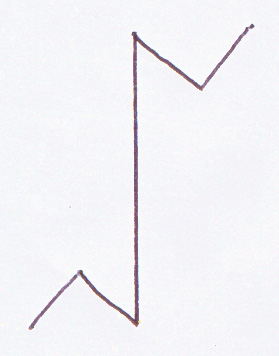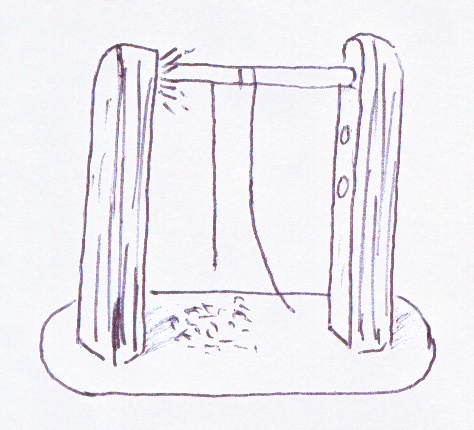|
|
||||
|
The Needfire For hallowing purposes, especially on special occasions such as a new altar, taking possession of a new residence, the Yule log and starting a new year, or a Midsummer fire, one may want a new, pure fire. Traditionally needfire was used for this. A needfire is a fire struck by mechanical friction, with no use of chemicals such as those on a match or the fuel in a lighter. The modern English name (and the cognate German Notfeuer) is deceptive: It is not in fact a “needed” fire but a fire made in a special way. The Anglo-Saxon word nídfýr and its Old Saxon relative nódfiur are almost certainly derived from a word meaning “rub” rather than “necessity,” and there are Norwegian and Swedish dialect words (rideld and vrideld) that have that meaning.1 Needfire was important in ancient heathenry. We have copious evidence from folk tradition of needfire being used to reignite the hearth fire every Yule; to light fires that people leaped through or drove cattle through for fertility and against disease; and to celebrate the solstices.2 Also needfire is twice mentioned among things the Church banned for the Saxons; the word nodfyr is translated as fracatum lignum, “rubbed fire,” and called “sacriligious fire.”3 Also, there is a reference in Eyrbyggjar Saga to reginnaglar—nails of the regin, of the gods—on the öndvegissulur (high-seat pillars) that Thorolf Mostrarskeggr floated ashore when he came within sight of Iceland so that he would know where Thor wished him to settle and build his hof.4 It occurs when we are told that he set up the pillars in the hof: Ţar lét hann reisa hof og var ţađ mikiđ hús. . . . Ţar fyrir innan stóđu öndvegissúlurnar og voru ţar í naglar. Ţeir hétu reginnaglar. “There he had a hof built, and that was a large building. . . . Inside it stood the high-seat pillars and there were nails in them. They were called reginnaglar.” Earlier, we were told that these were the high-seat pillars specifically from his hof in Norway, and that there was a likeness of Thor on one: öndvegissúlum sínum, ţeim er stađiđ höfđu í hofinu. Ţar var Ţór skorinn á annarri. There’s a remarkably similar detail about a Saami image of Hora Galles: Scheffer, in his Lapponia (1673), reports that he was depicted with both an iron nail and a piece of whetstone in his head.5 Hora Galles is derived from Thor—his name is a local pronunciation of Thor karl, “good ol’ boy Thor”—and Scheffer himself made the connection to Thor and the lightning.6 So it is possible that the reginnaglar only appeared on images of Thor, as allusions to his having the piece of whetstone stuck in his forehead since the encounter with Hrungnir. And perhaps the usual translation of “high-seat” pillars is a misunderstanding in this instance and reginnaglar only appeared on the central pillars of a hof.7 But however widespread reninnaglar were, they indicate that one method of making needfire is striking a light on a hallowed nail, a gods’ nail, in the pillar of a hof or on an image of Thor/Thunor/Donar. To create needfire by this method, you will need to have a hallowed pillar or god-image with a special nail in it used only for this purpose, or a special set of flints. The more common method is with a firebow or other “rubbing”apparatus. Here is a site with copious information and illustrations on how to do this in various ways (including starting a fire with a can of Coke and a chocolate bar, which, however, is not technically needfire since the sun creates the fire): Visit site here. Here is a reproduction of instructions from 1919 for making and using a firebow, probably the most widespread of the rubbing methods, as taught in the Boy Scouts: Visit site here. Kneeling with one foot on a board into which a sharpened dowel is fitted using a keyhole-shaped notch and steadying it at the top using one’s bent leg, one draws to and fro a fire-bow strung with a leather thong that is wound around the dowel in order to spin it in the slot.  Two things suggest that the needfire apparatus itself was sacred. The Northumbrian rune cweorţ is generally interpreted as a fire-twirl:8  One less familiar form of needfire apparatus involves two posts with a rod between them that rotates to produce sparks when a string wound around it is pulled. This has been connected by some scholars to the twin-cult of the Alcis referred to by Tacitus, since the names of the Vandal leaders Raos and Raptos can be construed as “post” and “rod.”9  Whenever making needfire, have tinder (shavings, etc.) ready to catch the sparks and be ready to manage the fire safely. Making a fire by rubbing is difficult and likely to be frustrating; if you can make it a meditative process, do so. The spindle should be a hardwood like oak or maple and the platform should be a softwood like pine or spruce, the friction takes advantage of the natural resin in the wood to assist in igniting the wood. Making a fire using wood on wood method can take as long as an hour to create enough of an ember to transfer to your tinder pile. Your tinder pile should consist of very dry materials such as dried grasses, dried leaves and if you are lucky enough birch bark. You can choose to pile your tinder on top of the birch bark or roll it inside, the roll method works best if you need to go any more than a few inches / cm from where your ember is. With the ember in your tinder bundle gently blow on it to encourage the ember to burn the tinder and create fire. (Three very different meditational focuses: Thor/Thunor/Donar and his lightning; Loki, if one associates him with fire; the fire and the ice that created life in Ginnungagap.) If not, allow considerable time, or alternatively consider the striking method and consider using flints; or even buy a lighter and use it only for sacred fire (as a dedicated tool), or use matches, since each match is used only once. Needfire is holy and for holy purposes; unless using the process of making it as an ordeal, it will be counter-productive to make fire in a way that gets you into a bad mood. Remember, the name is deceptive: “need” fire is not needed, it is frictional. For many purposes, fire created anew by some other method may be better than needfire. 1 Jan de Vries, Altgermanische Religionsgeschichte 1, 361 and note 1 (2nd ed., Berlin: de Gruyter 1956, repr. as 3rd ed. 1970). 2 de Vries 1, 461-63. 3 de Vries 1, 462, n. 2. 4 Saga text at Eyrbyggja Saga, The Story of Ere-Dwellers / Saga Ţórsnesinga, Eyrbyggja og Álftfirđinga at Voluspa.org 5 de Vries, Altgermanische Religionsgeschichte 2, 389 and n. 3 (2nd ed., Berlin: de Gruyter 1957, repr. as 3rd ed. 1970). 6 For the derivation of the name Hora Galles, de Vries 2, 419 and E.O.G. Turville-Petre, Myth and Religion of the North: The Religion of Ancient Scandinavia 98 and n. 27, p.299 (London: Weidenfeld & Nicolson, 1964). Scheffer’s statement is In capite infigunt clavum ferreum, cum silicis particula, ut si videatur ignem Thor excutiat, “In the head they inserted an iron nail, with a piece of whetstone, as if they would see Thor strike fire,” quoted from de Vries 2, 389 n. 3. 7 The Oxford Icelandic-English Dictionary (2nd ed. 1957, repr. 1975, commonly known as Cleasby-Vigfusson) cites only the Eyrbyggja Saga passage for regin-nagli (under “regin”) and all its citations for the öndvegis-súla (under “önd-vegi and önd-ugi”) refer to hofs or else do not say where the pillars came from, simply that settlers threw them overboard to wash ashore in Iceland as Thorolf did : Landnámabók 34, 35, 96, 261; Kormáks Saga 6, Gísla Saga 140. 8 E.g. Edred Thorsson, Rune Might: Secret Practices of the German Rune Magicians 39 (St. Paul, MN: Llewellyn, 1989). 9 de Vries 2, 249-50 and fig. 22.
|